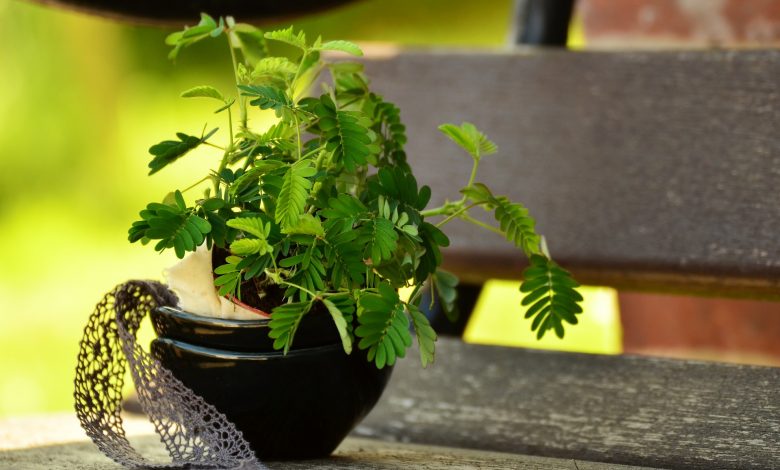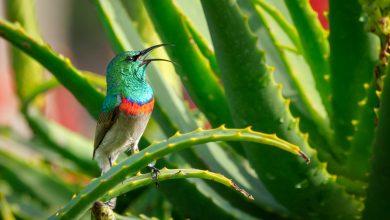Sensitive Plant Care: Growing the Mimosa Pudica

One of nature’s many delights, Mimosa pudica is a tropical plant native to Central and South America. Also nicknamed the sensitive plant, shame plant, and touch-me-not, Mimosa pudica is of the Fabaceae family of plants. Thus, it’s a relative of beans, peas, and other leguminous plants.
The sensitive plant has thorns growing on its stems. When grown indoors, it’s a short shrub (growing up to 24 inches) with creeping tendencies and can be influenced to spread or hang as it develops. Its feather-like leaves and small puffball pink or purple flowers are amazing enough qualities to make it a popular house plant. However, the most significant appeal of the shame plant is its leaves, which fold inward when touched or blown on. This curious response to external stimuli is the reason for the plant’s nicknames.
Although the plant is a popular indoor plant, it can also be grown outdoors. Still, it may become an invasive species, especially in hand cultivated fields. As a result, the Mimosa pudica is considered a weed in Asia, Hawaii, and Australia. Here’s everything you should know about growing the Mimosa pudica (sensitive plant) as a house plant.
What Makes the Sensitive Plant Sensitive?
The delicate feather-like leaves of the sensitive plant are themselves made up of pairs of smaller leaves with tiny sensitive hairs on them. These little hairs on the leaves’ surface cause the blades to close up when touched or exposed to higher temperatures, and the phenomenon is known as the nastic movement of the sensitive plant. Nastic movement refers to the motion of a plant in response to external stimuli.
Unlike tropic movements, where the plant moves either away from the stimulus or towards it (like when plants bend to the direction of the sun), nastic motions are independent of the stimulant’s direction. Thus, the leaves of the sensitive plant will close up, notwithstanding the particular section that was touched. The carnivorous Venus flytrap is perhaps the only plant beside the Mimosa pudica that exhibits nastic movement rapid enough to be observed in real-time.
Caring for the Mimosa Pudica
Particular areas of note in caring for the Mimosa are soil type, water, light, fertilizer application, temperature, propagation, and humidity.
Soil Requirements
Keep the sensitive plant in a well-drained and aerated soil. The Mimosa enjoys a consistently moist soil but will suffer root rot in an overly compacted soil, which will not permit water to drain quickly. The ideal soil for this plant is a mixture of loam, peat moss, and sand in the ratio 2:2:1 or a combination of equal parts perlite and peat moss.
Watering
The plant thrives in continually moist conditions but will suffer root rot if it gets excess water. To prevent the roots from rotting, apply moderate amounts of water only when the top layer of the soil is dry. To test the soil’s moisture content, put a finger into the sod to check for moisture.
Temperature
Generally, houseplants will survive in whatever temperatures you find comfortable. Room temperatures of 65 to 75 degrees Fahrenheit are suitable for growing sensitive plant. In the summer, you can take the plant outside if you wish, but note that high temperatures will cause the leaves to collapse.
Humidity
Unlike other houseplants from tropical environments that do not object to low humidity, the sensitive plant enjoys moderate to high moisture. Nonetheless, it can tolerate the average humidity of most rooms.
In winter, when room heaters may dry out the air, you may need to increase the humidity around the plant. To supply the required levels of moisture, you can use an electric humidifier or place the pot on a tray of pebbles filled with water. If you use a water-filled tray of pebbles, ensure that the container is above the water level so that water does not penetrate the soil through the drainage holes at the bottom of the pot.
Light
The Mimosa pudica might be sensitive to touch, but it does not shy away from light. If the plant must bear flowers, it will need at least three to four hours of direct sunlight daily. Windows to the east are ideal for Mimosa pudica, as it permits the morning sunlight. If such a window isn’t available, then position the plant two to three feet away from a west-facing window and five feet away from a south-facing window. Alternatively, full-spectrum fluorescent lighting can supply the required amount of light for the sensitive plant to bloom.

Fertilizing
In nature, the shame plant, along with other members of the Fabaceae family, thrive even in nutrient-deficient soils, as they have nitrogen-fixing abilities. This ability means that they can convert nitrogen molecules in the air into ammonia and other nitrogenous compounds for use in their growth. As a result of nitrogen fixation, the sensitive plant only requires potassium-rich, medium-strength liquid fertilizers.
Feed the plant once in two weeks during its growth period in spring. A good tomato fertilizer will work well on the Mimosa. Even after diluting, only apply fertilizer after you have watered the plant to prevent the roots from burning.
Potting
For better foliage and flowers, the Mimosa pudica prefers not to have its roots spread about the container. As such, you should avoid oversized pots. At the early stages, the ideal pot for the sensitive plant is one with a diameter of about three inches (eight centimeters), with holes at the bottom to allow water to drain away quickly. It should preferably be made of plastic, as terracotta pots tend to be porous and may absorb some of the water, resulting in a faster drying soil.
Repotting
Sensitive plants are fast-growing and will need repotting more often than slow-growing plants like the Hindu rope plant. You’ll know it’s time to repot the Mimosa pudica when the roots start growing through the drain holes in the pot.
Follow these steps to repot a Mimosa pudica:
- You’ll need a pot that’s a size or two bigger than the current one.
- Fill two-thirds of the new pot with the potting mixture.
- Carefully remove the plant from its current housing, and rub off any extra soil, ensuring that the roots are exposed.
- Prune off any damaged or dead roots with clean shears.
- Place the plant into the new pot, and cover the roots with a fresh potting mixture.
Propagation
The sensitive plant gets mostly propagated using seeds produced by the pink flowers when they bloom. The seeds are brown pellets with hard coats. To improve the chances of germination, you may need to pierce the coat with a sharp object to reveal the underlying white layer or soak them overnight in hot water. Either way, put three or four seeds in a moist growing medium and cover with a thin layer of soil, ensuring that they receive adequate warmth and light.
Ideally, you should plant seeds in the spring. However, with adequate artificial light and temperature, the seeds will germinate at other times. Sensitive plant seeds will germinate in seven to ten days in favorable conditions, including light and warmth. But they may take longer to grow or never germinate when the conditions are unsuitable.
When the seeds germinate, cast aside feeble looking seedlings; only nurse the strongest ones to maturity. It’s possible to grow the Mimosa pudica using stem cuttings. Nonetheless, using seeds is the preferred method of propagation, as it’s easier and faster.
To propagate with cuttings, take a branch having a leaf node, and plant it in the loam, peat moss, and sand mixture. Wrap the top of the plant and the pot with a plastic bag to keep the surrounding air humid.
Flowering
From summer to autumn, the Mimosa pudica produces light, pastel pink, or purple flowers, which grow on long stalks in clusters resembling powder puffs. The flowers produce flat pods that can contain up to six seeds. More flowers will appear as the plant ages.

Pruning
The Mimosa pudica has creeping tendencies and will begin to spread out as it matures. If you prefer it to remain upstanding, then regular pruning will keep the branches from spreading. Alternatively, consider installing a trellis to provide support for the drooping stems. It’s best to prune a Mimosa pudica plant in spring when the plant is experiencing active growth.
Pests and Diseases
Mimosa pudica is a sturdy plant, and as a houseplant, it is unaffected by most common pests. Still, the sensitive plant is susceptible to spider mites in times of high temperature but lowered humidity or in cases where other houseplants have these insects.
Spider mites appear as little red dots on the plant’s leaves and will cause the leaves to lose color and fall off. To rid the plants of these insects, first, spray the entire plant with water, and then apply insecticide. Due to the high humidity that this plant enjoys, it is particularly susceptible to fungal diseases. As a preventive measure, ensure that there’s proper circulation of air around the plant.
Toxicity
The Mimosa pudica has low levels of toxicity and is safe if inadvertently consumed by children or pets. Still, it’s best to consult a physician if you suspect that a child has ingested copious amounts of the plant.
Life span
Sensitive plants will live up to two or more years in their native tropical climates. As houseplants, it is best to treat them as annual plants, allowing them to die after the flowers produce seeds. You can always use the seeds to plant new Mimosa pudicas.



